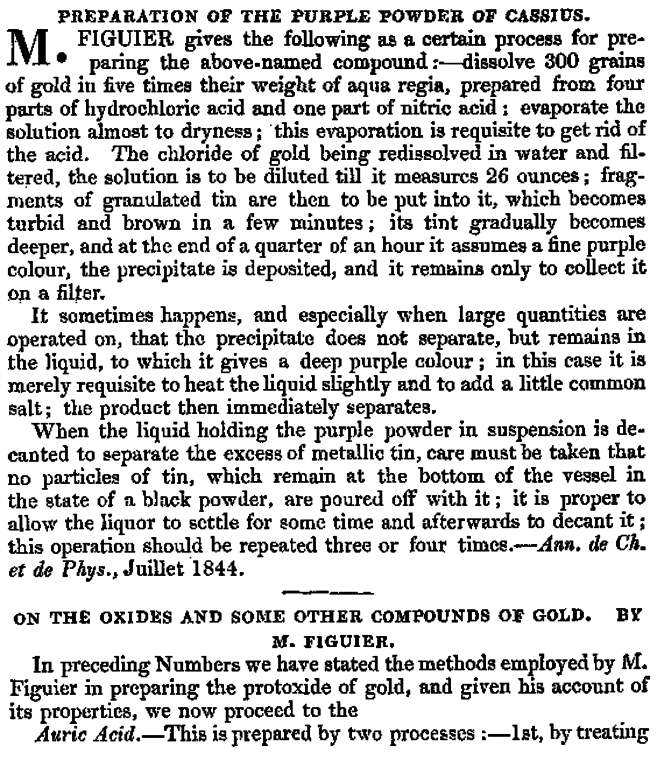Purple of Cassius was discovered by Cassius of Leyden in 1683. It contains gold and oxide of tin, and is used to colour glass and glazes, various shades of violet, red and purple being thus obtainable. Several methods of preparation are used, of which the following is that employed at the factory at Sevres:
Half a gramme of gold is dissolved in aqua regia composed of 16.8 grams of hydrochloric and 10.2 grams of nitric acid, and the solution is then diluted with 14 litres of water. To this solution is added, drop by drop, a solution of a mixture of protochloride and tetrachloride of tin, prepared as follows:—3 grammes of finely-divided tin is dropped, little by little, into 18 grammes of aqua regia (constituted as above, with the addition of 5 c.c. water), the reaction is checked by cooling if it is too violent, and the solution of chloride of tin formed is allowed to cool. The precipitate of purple oxide thus obtained is finely coloured when it has been washed with boiling water. The purple precipitate obtained by Muller, by reducing chloride of gold with glucose in an alkaline solution containing tin oxide in suspension, differs from that prepared by the foregoing method in losing its colour at a red heat, while the true purple of Cassius becomes brick-red under such conditions. The true colour is seen when metallic tin acts on trichloride of gold, or when alloys of gold and tin are attacked with nitric acid.
The composition of purple of Cassius has been the subject of much discussion. Some chemists have considered it to be a compound of aurous oxide with the oxides of tin. Debray regarded it as a lake of stannic acid coloured by finely-divided gold. Muller confirms Debray’s views, showing that fine purple compounds can be made with gold and magnesia, lime, baryta, sulphate of barium, the colour depending on the presence of finely-divided gold and not on the other constituent.
It was, however, shown by Schneider in 1893, that purple of Cassius is a mixture of the hydrosols of gold and stannic acid, and fresh evidence in support of this view was given by Zsigmondy. This investigator prepared a red solution of metallic gold in water by mixing formaldehyde rapidly with a feebly alkaline boiling solution of gold chloride. A solution of about 0.005 grams of gold in 100 c.c. of water was thus obtained and concentrated by dialysis, until an intensely red solution containing 0.12 per cent, of colloidal gold was produced. Neutral salts, mineral acids, and alkalies precipitate the gold and an excess of alcohol changes the colour of the solution to dark violet, completely precipitating the metal, which retains the property of dissolving in water. If shaken up with mercury, these solutions are rapidly decolourised. The gold is also carried to the bottom by freshly precipitated lead sulphate and other precipitates. Gold purple of required composition and shade may be obtained by mixing solutions of colloidal gold and colloidal stannic acid and adding dilute acids or salt solutions. Precipitated purple of Cassius prepared by Zsigmondy contained after washing and ignition 40.3 per cent, of gold and 59.7 per cent, of stannic acid.
Purple of cassius is only a form of colloidal gold. It is purple or red in colour and after the name of Cassius who discovered it.
Preparation of Purple of cassius
It is prepared by mixing very dilute solution of gold chloride with stannous chloride solution.
2AuCl3 + 3 SnCl2 → 2Au↓ + 3SnCl4
The gold thus precipitated is adsorbed by stannic hydroxide formed by the hydrolysis of SnCl4.
SnCl4 + 4H2O→ Sn(OH)4 + 4HCl
What is Purple of cassius used for? Purple of cassius is used in making ruby-red glass and high class pottery.

